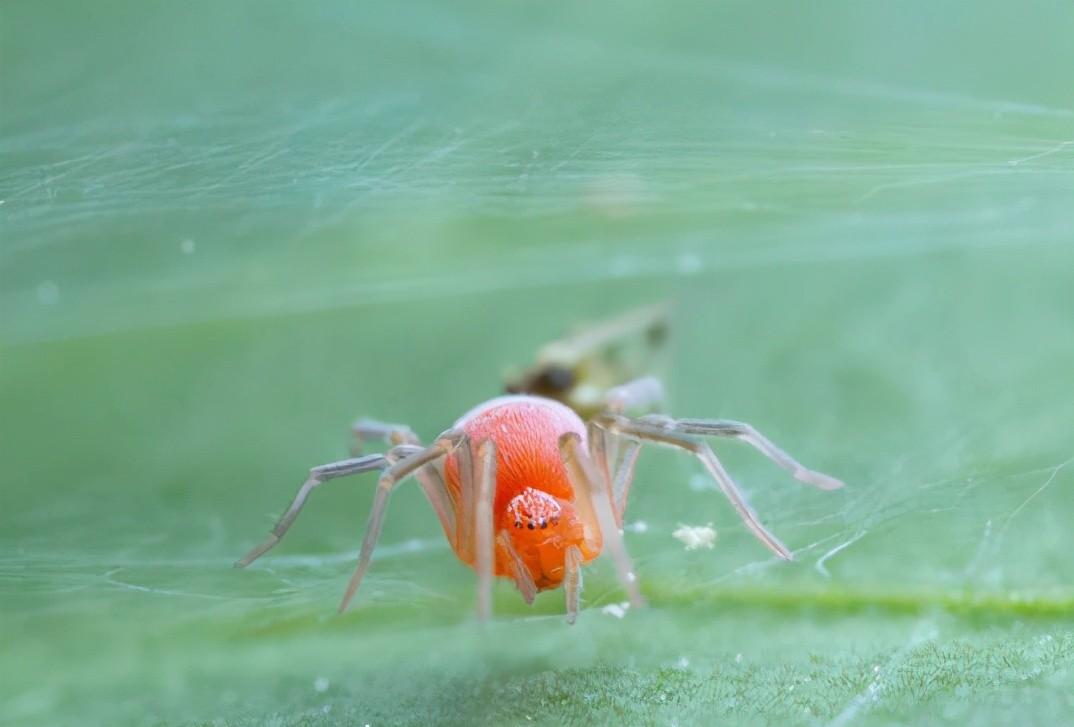Yesterday Teacher Feng went to inspect a tomato base of friends, found how his tomato leaves are a little gray-white, so he looked over a few leaves, and found that a small number of red spider traces appeared on the back of the leaves, and quickly shared some prevention and control methods to friends, so that he could carry out pesticide extermination in time. Teacher Feng saw such a situation in his tomato and felt that the red spider was coming very strongly this year. Tomatoes, peppers and other crops need to be prevented in advance, and if the control method is not correct, the more prevention will be, resulting in a reduction in crop yield. Therefore, with more than 40 years of practical experience, Teacher Feng shared with you some characteristics and prevention methods of red spiders.
First, the characteristics of red spiders
Red spiders, also known as leaf mites, are divided into red, yellow tea mites, white mites, cinnabar mites and so on.

It has the following five features:
1. The body size is small and not easy to be detected
The red spider is small in size , 0.42 to 0.52 mm , and is generally round or ovoid in shape , orange or reddish brown. Because of its small size, it is not easy to be discovered. If it is an ordinary farmer, when it is found that it is harmful, often tomatoes, peppers, etc. have been seriously affected. The southern red spider hazard generally starts from March to April of each year, and in the north from May to June, so farmers in the south and north should often check their tomato leaves, pepper leaves and other crop leaves at their own appropriate time.
2. Strong reproductive ability
Red spiders have a strong reproductive ability and a particularly fast reproduction rate, with only 7-10 days per generation and only about 5 days at the shortest to reproduce a generation. The breeding cycle of red spiders changes with temperature changes, according to relevant research studies, the following conclusions have been obtained:
■ When the temperature is 25 °C, it takes about 16 days to complete a generation;
■ When the temperature is 30 °C, it takes about 12 to 14 days to complete a generation;
■ When the temperature is low in winter, the rate of completion of a generation is extended to 63 to 75 days (mainly because the egg development period is prolonged).
Therefore, now spring and summer are coming, the temperature is in a rising stage, the breeding cycle of red spiders is getting shorter and shorter, and the reproduction rate is getting higher.
3. Hidden deep on the back of the leaf
Red spiders are generally harmed on both sides of the main vein on the back of the leaf, mostly clustered on the back of the tomato and pepper leaves, spitting silk knots on the back of the leaves, and gradually spreading throughout the leaves from several small groups. The way the red spider spreads and spreads and infects mainly by crawling on its own, in addition, wind, rain and agricultural operations are also a way for it to spread, generally in pieces.
4. There are many types of natural enemies
The natural predators and numbers of red spiders are relatively large, mainly including deep-spot mite-eating ladybirds, bundle-feeding mite ladybirds, heterochromatic ladybirds, large and small grasshoppers, small flower bugs, plant mites, etc. These days play an active role in controlling the population of red spiders. Therefore, when controlling pests, farmers try to avoid harming natural enemies of red spiders.
5. Prefer high temperature and dry environment
Red spiders have the strongest reproductive ability and greater degree of harm in high temperature, dry and poor ventilation environments. Most red spiders are high-temperature active. Therefore, in the spring and summer, watering should be done in time to change a high temperature and dry environment as much as possible.
Second, prevention and control methods
For red spiders, how should farmers control them? The following are some prevention and control measures shared by Teacher Feng from the aspects of physics and chemistry.
Physical control
Timely remove the yellow leaves, old leaves, diseased leaves and diseased residual fruits at the bottom, properly water them, and strengthen field management.
Do a good job of clearing and pruning in winter to reduce the source of insects.
Check the plant for mite egg masses in time, and remove the pruned plants and plants containing insects in time.
chemical control
For the chemical control, medication and formulation of red spiders:
Medications: monomethylamidine, triazol tin, acetazole, tetramethoxylum, spironoate, avermectin, etc. are used alternately.
formulation:
Avi biphenylhydrazine, mite-egg double killing, has a special effect on various mites.
40% acetopyridoxine + 10% avypyridine (special effects).
10% bifenthrin + 30% thiamethoxam + 5% louse alfalfa (special effects).
Triazoltin + avermectin, mite-egg double killing, red spiders are not easy to develop resistance.
Avi mineral oil + 20% pyridoxine wet powder, red spiders are not easy to develop resistance.
Teacher Feng's suggestion is that the above formulas are rotated, and the drug effect above 25 °C is the best, so that the killing of red spiders is strong and the red spiders are not easy to resist.
If you want to know more about agronomy, you can pay attention to "Teacher Feng's Field" and contact us by private message to get more application skills. If you have any questions, please leave a message in the comment area. So that you can view the article at any time, please remember to click on follow + favorite Oh ~